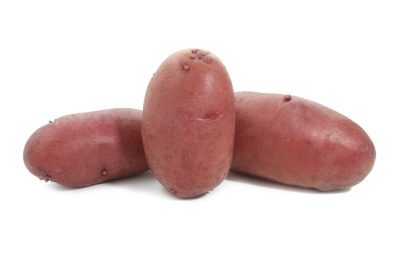
- Authors: Wolfgang Walter, Germany (Norika Nordring-Kartoffelzucht und Vermehrungs-GMBH)
- Name synonyms: Merlot
- Year of approval: 2015
- Appointment: dining room
- Tuber size: medium to large
- Tuber weight, g: 89-139
- Peel color: red
- Color of the pulp: dark yellow
- Starch content,%: 15,7-16,1%
- Tuber shape: oval
Growing potatoes, gardeners and farmers try to choose those varieties that ideally adapt to the climatic conditions of the region. For the Central region, the late variety Merlot, of German selection, is optimal for cultivation.
Breeding history
Merlot potatoes appeared thanks to the work of German scientists from the agricultural company Nordika Nordring-Kartoffelzucht und Vermehrungs-GMBH. The author of the variety is Wolfgang Walter. Potatoes approved for use and entered in the register in 2015. The nightshade crop is the most productive, growing in the Central region.
Description of the variety
Merlot is a medium-sized shrub of an intermediate type, growing up to 50-60 cm in height. The plant is characterized by compactness, semi-erect stem and moderate thickening with small bright green leaves. Flowering occurs approximately 50-60 days after planting. At this time, rare flowers of a red-purple color are formed on the potato bush. A characteristic feature of the bush is a powerful, thickened stem.
Characteristics of the appearance of the bush and root crops
On one bush, from 6 to 11 root crops are formed and grow. The potato has a regular oval shape with a smooth surface. As a rule, tubers grow in the same size and shape, that is, aligned. The color of the potato is unusual - red, uniform. The peel is of moderate density with a pronounced mesh and a few eyes, shallow set. The average fruit weight is from 89 to 139 grams.
The harvested crop can be transported over long distances, as well as stored for a long period. The main thing is that there is no excessive moisture in the cellar or in the basement, otherwise the potatoes will begin to sprout.
Purpose and taste of tubers
Table potatoes taste great. The dark yellow flesh has a dense, buttery and delicate texture. Potatoes boil well and are characterized by excellent crunchiness. After cleaning and heat treatment, the pulp does not darken. The root vegetable contains about 16% starch, as well as a high content of protein and vitamin C. Merlot table potatoes are ideal for frying, stewing, baking, and also added to first courses, salads.
Maturation
German potatoes are late-ripening varieties. The growing season can last from 95 to 115 days. Root crops ripen together. The first digging can be carried out at the beginning of autumn, and the mass harvesting takes place at the end of the month.
Yield
The variety is characterized by a stable and high yield. If agrotechnical recommendations are observed, from 190 to 355 centners of tubers can be dug out per hectare of plantations. The maximum yield was recorded at the level of 500-504 centners.
Growing and caring
Potatoes are planted in the first half of May, when the temperature has stabilized (+ 10-12 degrees) and the soil is sufficiently warmed up to a depth of 8-10 cm. For planting, medium-sized potatoes (70-80 g) with shoots of 1-2 cm are selected. according to the scheme 35x60 cm. The ridges are located from south to north.
It is not recommended to plant in an area where tomatoes, eggplants or potatoes previously grew. The best predecessors are cucumbers, peas, cabbage, beans, lupine.
Cultural agrotechnology consists of a number of activities: irrigation (for the southern regions, a drip irrigation system is ideal), loosening and weeding of row spacings, hilling, which increases productivity by 30-40%, top dressing (three times per season), prevention of diseases and insect infestations.

Planting potatoes is one of the main spring activities traditional for Russian gardeners. There are many ways to plant this vegetable, allowing you to get a good harvest in different conditions and climates. Before planting, you need to carefully prepare the planting material, correctly determine the timing, competently prepare the soil.


Soil requirements
Potatoes are undemanding to care for, but very sensitive to the quality of the soil. The soil should be fluffy, moist, nutritious, breathable and with a low acidity level, since potatoes grow poorly in acidic soil. If the groundwater is not very deep, then potatoes are planted on the ridges.
The crop is most productive if it grows on fertile soil, for example, on chernozems, loams, sandy loam and sand mixtures.

Required climatic conditions
The German variety is thermophilic, resistant to short-term drought, loves light and space, so the site for planting potatoes is chosen where there is a lot of sun and there is protection from gusty winds and drafts.
It is also worth considering that nightshade culture reacts negatively to prolonged shade and moisture stagnation, which can lead to a significant decrease in productivity.
Disease and pest resistance
The variety has a complex immunity that protects against many fungal and bacterial infections. The potato crop is resistant to cancer, leaf curling, golden nematode, blackleg and glandular spot.
Black and common scab, late blight of leaves and tubers are dangerous for potatoes. As for pests, most often the bushes are attacked by the Colorado potato beetle, which will help to get rid of comprehensive prevention and treatment.

Potatoes are a popular vegetable crop that many gardeners planted on their site. But growing a bountiful harvest of tasty and large tubers is unlikely to succeed if the beds are not properly protected from the most common diseases and pests. Often, the development of diseases of various etiologies of potatoes goes unnoticed, so it is important to identify the problem in time and eliminate it.
















































































